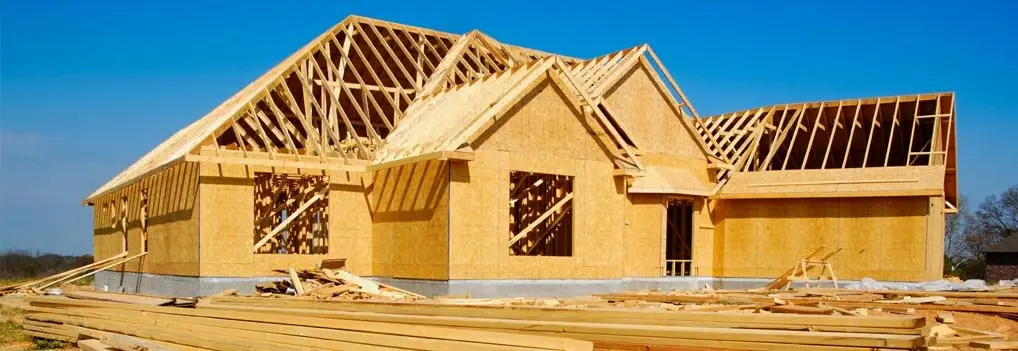What are the Stages of Construction?

Stage 1: Site preparation & foundation pour
After clearing the site of trees and debris, the construction crew levels the ground, puts up wooden forms to serve as a foundation template and digs any necessary holes and trenches. Footings (structures where the house interfaces with the earth that supports it) are installed. If your home is going to have a well, it will be dug at this point.
If the home is designed with a full basement, the hole is dug, the footings are formed and poured, and the foundation walls are formed and poured. If it’s slab-on-grade, the footings are dug, formed and poured; the area between them is leveled and fitted with utility runs (e.g. plumbing drains and electrical chases); and the slab is poured.
Once concrete is poured into the holes and trenches, it will need time to cure. After the concrete is cured, the crew applies waterproofing membrane to the foundation walls; installs drains, sewer and water taps and any plumbing that needs to go into the first-floor slab or basement floor; and backfills excavated dirt into the hole around the foundation wall.
INSPECTION #1: After the curing process, an inspector visits the site to ensure foundation components are up to code and installed properly. This inspection may be repeated depending on the type of foundation (slab, crawl space or basement). The builder will then remove the forms and begin coordinating stage 2, the framing phase.
Stage 2: Rough framing
The floor, walls and roof systems are completed. Plywood or oriented strand board sheathing is applied to the exterior walls and roof, and windows and exterior doors are installed. The sheathing is then covered with a protective barrier known as a house wrap to prevent liquid water from infiltrating the structure, while allowing water vapor to escape. This reduces the likelihood of mold and wood rot.
Stage 3: Rough plumbing, electrical, & HVAC
Once the shell is finished, siding and roofing can begin. At this time, the electrical and plumbing contractors can also run pipes and wires through the interior walls, ceilings and floors. Sewer lines and vents, as well as water supply lines for each fixture, are installed. Bathtubs and one-piece shower/tub units are put in place.
Ductwork is installed for the heating, ventilation and air-conditioning (HVAC) system, and possibly the furnace. HVAC vent pipes are installed through the roof, and insulation is installed in the floors, walls and ceilings.
After the roofing is on, the electrician installs receptacles for outlets, lights and switches and runs wires from the breaker panel to each receptacle. Wiring for telephones, cable TV and music systems is included in this work.
INSPECTIONS 2, 3 and 4: Rough framing, plumbing and electrical and mechanical systems are inspected for compliance with building codes. Most likely these will be three different inspections. At the very least, the framing inspection will be conducted separately from the electrical/mechanical inspections.
Stage 4: Insulation
Insulation helps to create a more comfortable, consistent indoor climate while significantly improving a home’s energy efficiency. Most homes are insulated in all exterior walls, as well as the attic and any floors that are located above unfinished basements or crawl spaces.
Stage 5: Drywall, interior primer finishes & begin finishes
Drywall is hung and taped so the seams between the boards aren’t visible, and drywall texturing (if applicable) is completed. The primer coat of paint is also applied after taping is complete. Contractors then begin installing exterior finishes such as brick, stucco, stone and siding.
Stage 6: Finish interior trim; install exterior driveways & walkways
Interior doors, baseboards, door casings, windowsills, moldings, stair balusters and other decorative trim are installed, along with cabinets, vanities and fireplace mantels and surrounds. Walls get a final coat of paint.
Exterior driveways, walkways and patios are generally formed at this stage, but some builders prefer to wait until the end of the project before pouring the driveway.
Install hard-surface flooring and countertops; complete exterior grading: Ceramic tile, vinyl and wood flooring are installed as well as countertops. Exterior finish grading is completed to ensure proper drainage away from the home and prepare the yard for landscaping.
Finish mechanical trims and install bath fixtures. Light fixtures, outlets and switches are installed and the electrical panel is completed. HVAC equipment is installed and registers completed. Sinks, toilets and faucets are put in place.
Mirrors, shower doors and carpeting are installed, and final cleanup takes place. Trees, shrubs and grass are planted and other exterior landscaping is completed.
INSPECTION #5: A building-code official completes a final inspection and issues a certificate of occupancy (C.O.). If any defects are found during this inspection, a follow-up inspection may be scheduled to ensure that they’ve been corrected.
Stage 7: Final walkthrough
Your builder will walk you through your new home to acquaint you with its features and the operation of various systems and components. There will also be an explanation of your responsibilities for maintenance and upkeep as well as warranty coverage and procedures. It’s also an opportunity to spot items that need to be corrected or adjusted, so be attentive and observant. Examine the surfaces of countertops, fixtures, floors and walls for possible damage that can be documented and/or repaired prior to move in.

For information about any of our properties, selling your home, or questions about our brokerage, please don't hesitate to contact us today!
